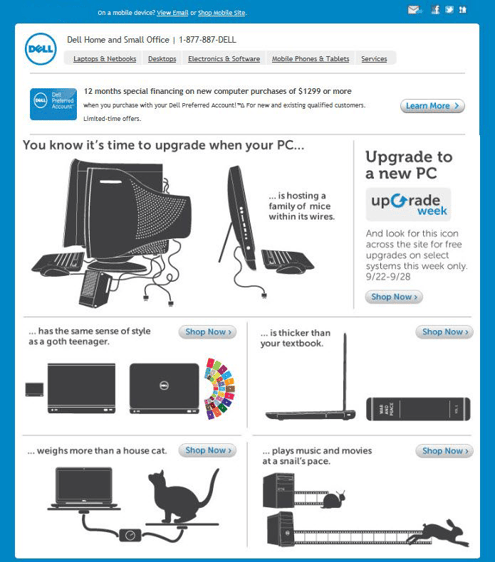5 Ways How To Re-Engage Customers With Email

Subscribe to our newsletter
Updated October 11, 2024
It can be easy to feel you're doing all you can, retailers. I'm sorry, but we've changed our buying habits. That's why you need to re-engage customers with email now.
Dodd's Bookstore, a cornerstone on Second Street in Belmont Shore, was closing after nearly 30 years in business, and I approached them to inquire about purchasing their email address list. What was the owner's reply?
“We don’t have an email list; we didn’t need one.”
I often see stores fail to re-engage their customers via email or only use email to offer a discount.
Those attitudes keep many stores’ sales small.
To get your clients to return more often, let’s begin with the most basic rule: You must provide an exceptional experience. That means you have a selling system with strategies for greeting a customer, generating an engaged customer, and closing the sale.
At the same time, you want to focus on customer retention's lifetime value rather than on a single transaction.
Importance of Customer Re-engagement
When I was in the coffee business, a barista blew off a customer over a $4 cup of coffee. I had to show them that most of our patrons stopped in every weekday, making the average yearly value of that one lost customer about $1000. One poor experience cost us almost ten times what the single purchase entailed.
It only makes sense then that those who’ve had a good customer experience with your store will be open to your marketing messages.
Cost Comparison
Acquiring a new customer is typically 5 to 25 times more expensive than retaining an existing customer. This substantial difference in costs is due to the extensive marketing and advertising efforts required to attract new customers compared to the more targeted and efficient approaches used for retention.
Profitability Impact
Increasing customer retention rates by just 5% can significantly boost profits, ranging from 25% to 95%. This demonstrates the powerful impact that focusing on customer retention can have on a company's bottom line.
Sales Success Rates
- The success rate of selling to existing customers is much higher than that of selling to new prospects:
- Selling to existing customers: 60-70% success rate
- Selling to new prospects: 5-20% success rate
Customer Behavior
- Existing customers tend to be more valuable in terms of their purchasing behavior:
They are 50% more likely to try new products
They spend 31% more compared to new customers
And before you dismiss email marketing, the Content Marketing Institute says it is the most effective digital channel.
Do you think millennials can’t be reached?
Consider this: Millennials are obsessed with email. More than half of millennials ages 18 to 24 check their email while still in bed in the morning, and 43 percent of millennials ages 25 to 34 report doing the same.
Those figures were from before Covid. Now, with more and more customers working remotely instead of commuting, emails are working better than ever.
In short, if you want to be where your customer base spends their time...that’s on email.
Since you have their email addresses because they have purchased from you before, don’t be afraid to employ an email campaign to email your customer list regularly to re-engage them.
While repeat customers and purchases are your ultimate marketing goal, it’s important to remember that your current customer probably doesn’t want or need a hard sell.
You want to keep them engaged and interested in your brand. That old saying is still valid, out of sight, out of mind.
A great email doesn’t seem like an ad; it seems like a favor.
That said, you need to provide value. No one wants clutter in their inbox. Before you hit send, ask yourself, "If I were receiving this, would I click on it?" If yes, then proceed.
Here are five types of emails to best re-engage your customers:
The replenishment email. Is there something you carry that runs out and needs replenishment? This could be as simple as shoe polish, as necessary as dog food, or as complicated as vintage wine. If your customers are sent an email about how you can set those products up on a subscription to be sent to their homes automatically, they'll appreciate not having to schlep heavy or awkward staples home.
The joint event email. I had a client who co-hosted an event, The Secrets Every Smart Woman Should Know About How To Dress A Room. She teamed up with a woman’s apparel store to show the similarities between getting dressed – the appropriate foundations, the choice of color, the look you were trying to achieve, the appropriate fabric choices and accessories – and showed how those same decisions she already made daily applied to creating a beautiful room. Both brands received more business in several joint emails sent to their own email lists. You could even upsell a Zoom consultation in that email.
The weather email. Being local has its advantages. An email tied to the local weather described the weather forecast for a hair problem like frizzy. You could use similar product tie-ins in a similar format if you are a hair salon. Still, as a home center, the weather shows Lawn Mowing, a sporting goods store, the weather shows Early Morning Run...pretty much you name it...and any humor is a bonus.
The informational email. Choose a common problem or topic for your customer—not drinking enough water, being stuck wearing the same old thing, etc.  Then, email them some reasons why it happens and strategies to help. Even better would be a blog post you email and link to your website. See how this email answers a pet owner’s concern, How To Understand What Your Dog Is Telling You. What could you offer to help demystify common struggles with your product?
Then, email them some reasons why it happens and strategies to help. Even better would be a blog post you email and link to your website. See how this email answers a pet owner’s concern, How To Understand What Your Dog Is Telling You. What could you offer to help demystify common struggles with your product?
Make them aware it’s time for an upgrade. Admittedly, this seems more geared to electronics, but it could be adapted to shoes, place settings, jewelry, clothing, etc. Taking a page from BuzzFeed’s popular list posts, send an email instructing them how to know when a specific item needs replacing, like in the example below.

Of course, you can do this only if you have an email address list, and you must religiously try to grow that list with every customer if you take holding onto them seriously.
I hope you do because the big retailers you are competing with, like Amazon, Walmart, and Target, are laser-focused on keeping their customers.
Everyone on your email address list gave you permission to be contacted, so your email will end up in their inbox. (And beware: the GDPR regulations are worldwide, so be compliant wherever you are.)
Compare that to social media...
On Facebook, only 1-2% of your fans will see a single post unless you boost it. Boosting costs money, while email is free.
Don’t get me wrong, social media is great for getting exposure, but an email to your customer list is a better sales predictor because it directly contacts your list of people who have spent money with you.
Imagine how big your email list could be if you had been actively nurturing it for five or more years.
And as you develop your re-engagement strategy, you must look at the most basic...
Measuring Email Campaign Success
With Apple privacy and others, such measures as opens aren't good. What matters most are click-thru rates and conversion rates. That's why you don't want to put everything into your newsletter; you want them to read more or keep reading so they have to take action.
In Sum
Again, the point is out of sight, out of mind. If you don’t stay in front of your customers, they’ll forget you.
While you could be spending a lot of money to attract strangers to shop with you, that’s expensive in both time and money. It won't do as much to grow your retail sales as to get people who already know you to return either curbside or in person.
How to sell more?
You must constantly think of new ways to speak to your tribe of clients that aren’t based on "We have a sale!"
Greater and greater discounts effectively transform your once loyal customers into discount shoppers willing to shop anywhere. Look no further than Gap; they can’t seem to go a weekend without a 40% off sale.
While you can attract and retain shoppers with loss leaders, you profit from profitable clients.
Use these email tips and ideas to get your brick-and-mortar customers to return repeatedly.



